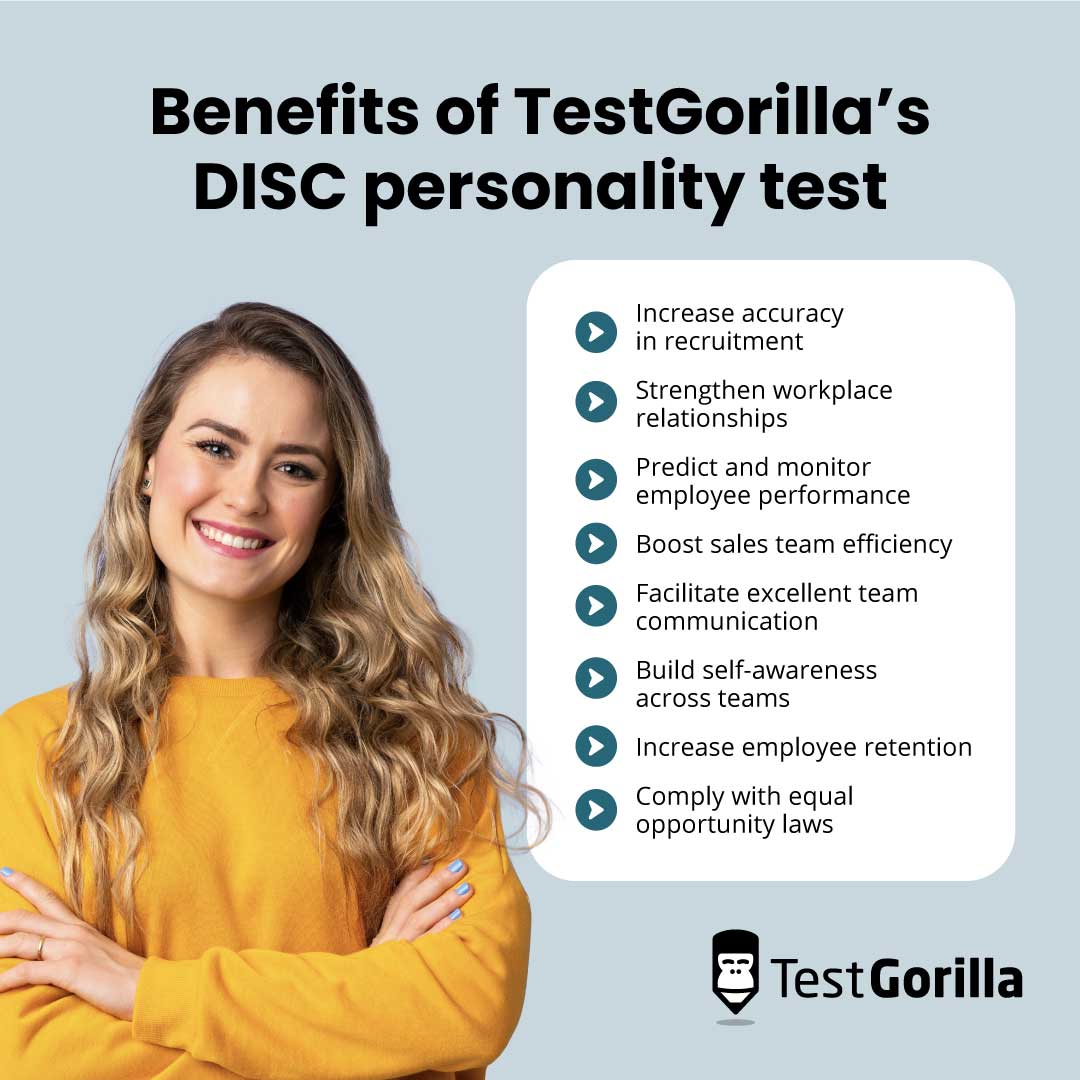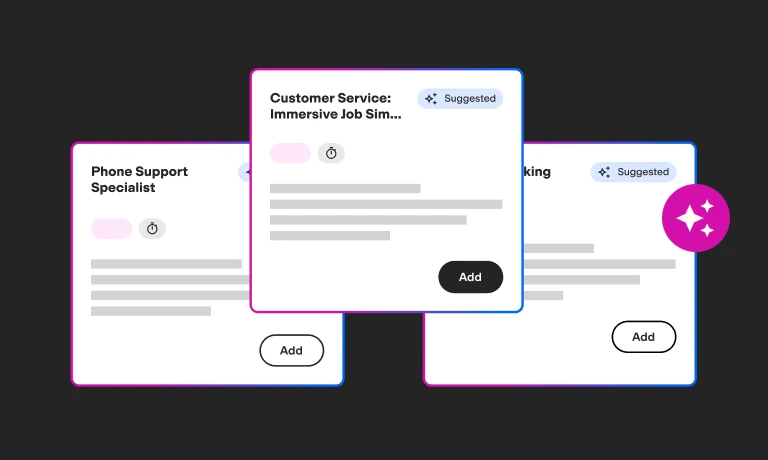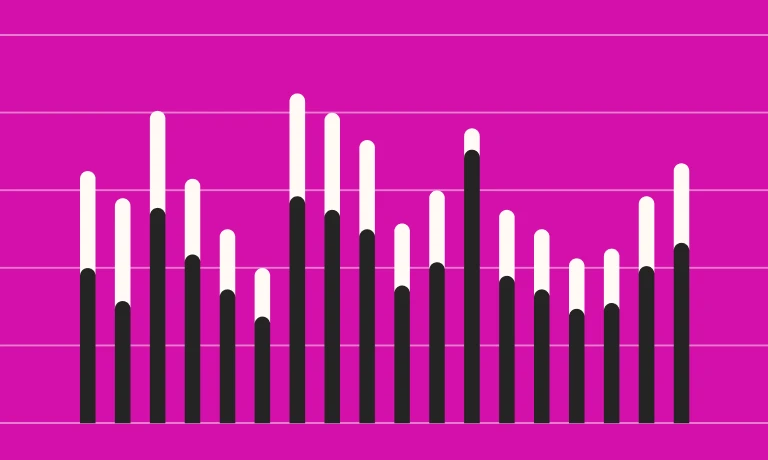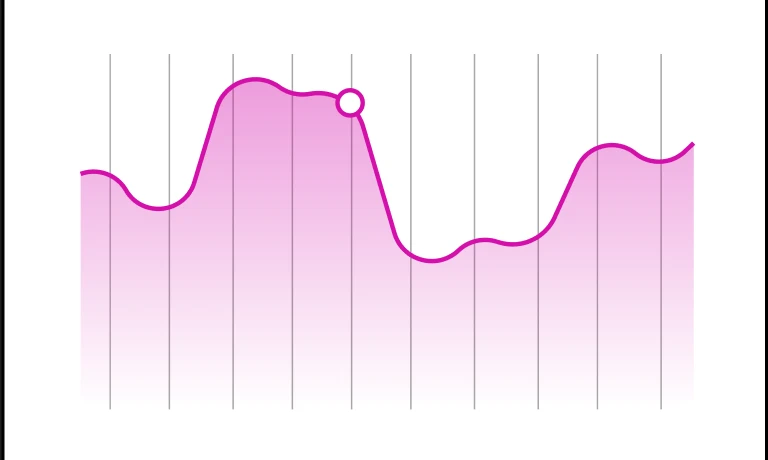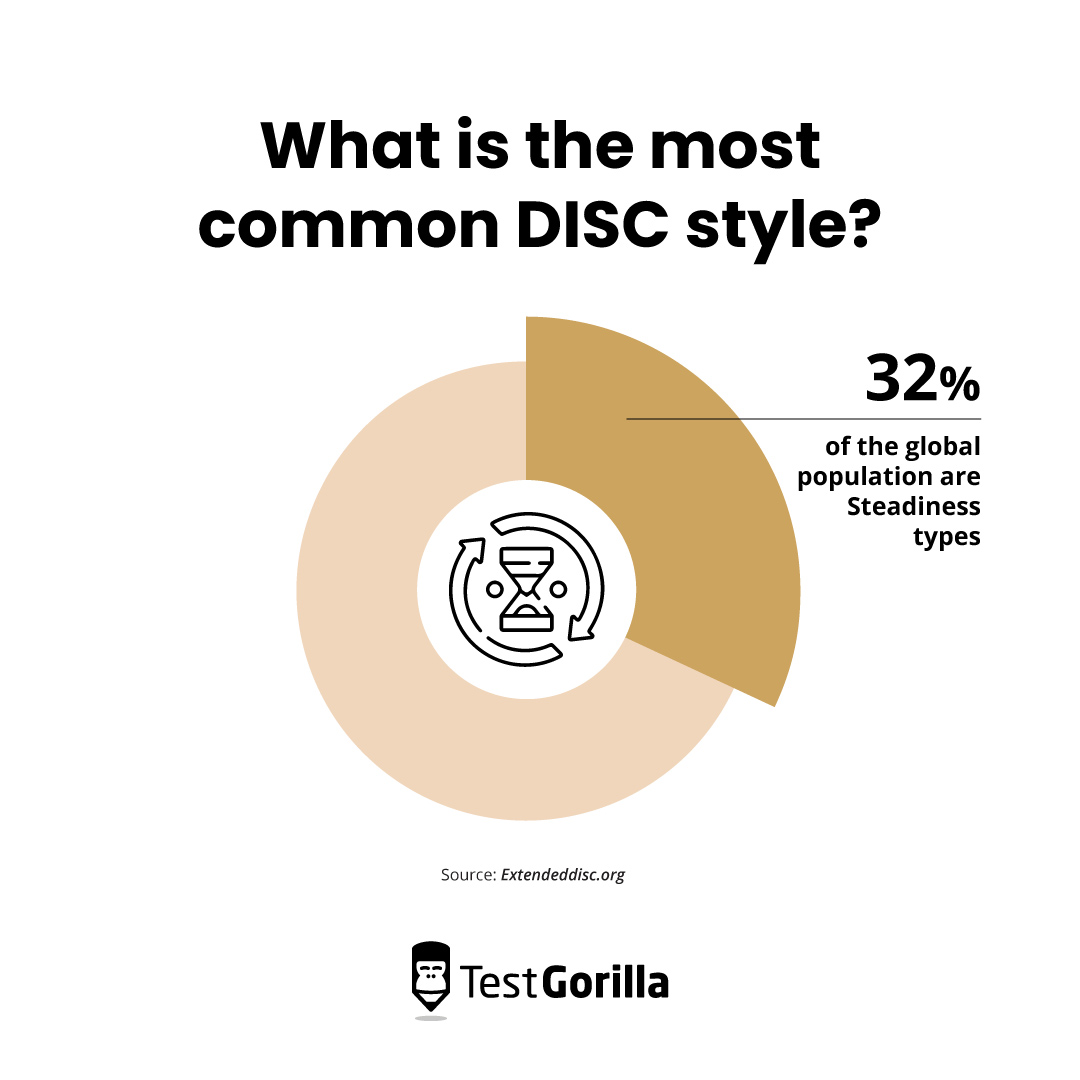The 4 DISC assessment personality types (+ 12 style combinations)
Learning the personality types within your talent pool and current workforce is an important part of creating and managing a successful organization.
A DISC assessment can help you understand your prospective hires and current employees’ personalities, but how do you know which personality type is right for your business?
In this article, we explore the four DISC assessment personality types, the 12 possible style combinations test-takers can have, how each combination can benefit your workplace, and which roles are the best fit for a particular personality type.
What is the DISC model and what does it measure?
The DISC model is a theoretical framework that breaks down human behavior into four categories, or “styles.” These are Dominance, Influence, Steadiness, and Conscientiousness.
Psychologist William Moulton Marston first introduced the theory in 1928. Since then, the DISC model has evolved into a self-administered personality assessment. It helps businesses and individuals understand how one’s behavior impacts group interactions, their communication style, and their relationships at work.
TestGorilla’s DISC assessment
Our DISC Personality test measures candidates’ preferences for each behavior in the DISC model based on their responses to 48 statements.
Candidates rank each statement from 1 (“very inaccurate”) to 5 (“very accurate”). Their responses will determine whether they fit into one of the four personality types or one of 12 style combinations.
Our DISC Personality test offers several benefits. They can help you:
Increase accuracy in recruitment
Strengthen workplace relationships
Predict and monitor employee performance
Boost sales team efficiency
Facilitate excellent team communication
Build self-awareness across teams
Increase employee retention
Comply with equal opportunity laws
The best insights on HR and recruitment, delivered to your inbox.
Biweekly updates. No spam. Unsubscribe any time.
The 12 DISC styles and career types for each
While each personality type has its strengths and weaknesses, no one style or combination is better than another. It all depends on the personality makeup of your organization and what role you’re trying to fill.
Let’s explore the 12 DISC styles and the careers that best fit each.
Dominance (D)
Candidates who fit primarily in the Dominance style are results-driven, direct, and confident. They try to shape their environment through action and leadership but can be demanding and may lack empathy.
Dominance types benefit businesses with fast-paced work environments, as they can make important decisions quickly.
Career types for Dominance style | Why they’re a good fit |
Chief executive officer | Tasked with creating and enforcing organizational strategies, making company-wide decisions, and getting the best performance out of their employees. |
Police officer | Required to make quick decisions that impact the safety of individuals and communities. As authority figures, they respond to emergencies and enforce laws. |
Project manager | Ensure teams complete projects efficiently and effectively. They’re focused on creating the best results for their business through leadership and organization. |
Event planner | Coordinate every aspect involved in making an event run smoothly. They decide on venues, caterers, and service goals. They must also make quick logistical decisions. |
Dominance and Conscientiousness (DC)
The Dominance and Conscientiousness style is an emphasized Dominance type also influenced by Conscientiousness traits like precision, objectivity, and a fear of criticism.
DC types are results-driven but place a strong emphasis on the details. They’re valuable to organizations that require confident leadership and a focus on executing logistical tasks.
Career types for Dominance and Conscientiousness style | Why they’re a good fit |
Physician | Diagnose and treat patients with illnesses, injuries, or who require ongoing care. They interpret medical histories and test results and make frequent, accurate decisions. |
Lawyer | Represent and advise clients in legal matters. They interpret and make arguments based on legal analysis and the rules governing criminal and civil court proceedings. |
Research leader | Manage a team of researchers throughout developing and conducting a research study before interpreting the findings. They occupy a leadership role and provide a strategic, detail-oriented mindset |
Responsible for all financial decision-making like cash flow, investment planning, and taxation. They oversee accounting and finance teams to ensure an organization’s financial health. |
Dominance and Influence (Di)
This combination is primarily Dominant but emphasizes innovation, creativity, and forward-thinking.
An individual with a Di style tends to approach leadership with enthusiasm, optimism, and a desire to persuade others to adopt their point of view. They love working in teams and are excited by change.
Di types are valuable to organizations that need outside-the-box thinkers who aren’t afraid to include others in their strategic vision.
Career types for Dominance and Influence style | Why they’re a good fit |
Marketing director | Develop and oversee strategies to promote products and services. They’re creative leaders who use precise and unique marketing techniques to boost sales and brand awareness. |
Advertising executive | Oversee the development and execution of ad campaigns and act as the middle person between the agency and its customers. They decide the core message of a campaign and ensure their teams stay connected. |
Social media manager | Develop, implement, and manage content strategies on an organization’s social media platforms. They’re decisive community-builders that connect brands to consumers. |
Influence (i)
Those with an influence style tend to be outgoing and passionate and try to persuade others of their point of view. They value freedom of expression but are afraid of rejection and disapproval.
Influence personality types will benefit organizations looking to energize their existing teams, increase communication, and build a positive workplace culture.
Career types for Influence style | Why they’re a good fit |
Creative director | Develop and manage advertising campaigns and shape brand standards. Successful creative directors recognize and nurture talent and use their influence to motivate their teams. |
Realtor | Help people purchase and sell real estate. Good realtors have excellent communication and negotiation skills and have a positive outlook when faced with challenges. |
Public relations manager | Lead organizations’ communication strategies by managing PR teams, delegating tasks, and engaging audiences across media platforms. They rely heavily on building relationships and communicating with confidence. |
Influence and Dominance (iD)
Influence and Dominance types love adventure. They set ambitious goals and use their charisma to bring collaborators on board. These individuals seek to lead through inspiration but can come off as intimidating or pushy.
Those with iD styles can be impulsive and struggle in consistent workplace environments. That said, iD types can be a great fit for organizations that value risk-taking or operate in a non-traditional work environment.
Career types for Influence and Dominance style | Why they’re a good fit |
Content writer | Produce written content for clients like blogs, brands, and news outlets. They may work in a traditional office environment but also thrive in flexible roles where projects change frequently. |
Recruiter | Help connect talented workers with organizations looking to hire. They have excellent interpersonal skills and industry knowledge. |
Outside sales representative | Sell products and services through face-to-face interactions. Since their role requires travel, they thrive in unfamiliar settings where relationship-building is key. |
Influence and Steadiness
The iS personality style is friendly, warm, and empathetic. iS types’ main priority is keeping the peace in the workplace and their professional relationships.
Although they don’t crave the spotlight, they value interpersonal communication and team building through kindness and support. They tend to seek collaboration but are afraid to pressure others, so they avoid confrontation at all costs.
iS styles can help boost your organization’s morale and uncover top performers through thoughtful interaction and encouragement.
Career types for Influence and Steadiness style | Why they’re a good fit |
Guidance counselor | Help students develop and achieve their academic and life goals. They’re great listeners and identify students’ strengths and interests through empathy and social awareness. |
Graphic designer | Design graphics for print and digital outlets and publications, like firms or individual clients. They actively listen to translate project goals into visual assets. |
Support and evaluate individuals and families suffering from injuries, disabilities, legal issues, or addiction. They’re empathetic and insightful caregivers that offer solutions to improve lives. |
Steadiness (S)
S types are primarily peacekeepers. They value cooperation, mutual support, and stable work environments to maintain performance. They tend to be calm and prioritize modesty, compromise, and helping their coworkers.
Since they prioritize the group, S types tend to downplay their own needs, which can lead to communication breakdowns or a lack of confidence in their abilities.
They’ll benefit organizations that require sustained empathy and active listening skills. These individuals offer advice that considers their coworkers' and customers’ emotional well-being.
Career types for Steadiness style | Why they’re a good fit |
Mental health therapist | Rely on active listening, expert communication, and empathy to understand patients’ emotional state and offer care. |
HR manager | Manage an organization’s candidate and employee relations strategies. They’re the bridge between management and the workforce to ensure everyone is treated with respect and has the tools to succeed. |
Physician assistant | Practice medicine and provide therapeutic care to patients under licensed physician supervision. They perform examinations, prescribe medications, and show empathy throughout each patient’s treatment. |
Steadiness and influence (Si)
Si personality styles are generous with their time and resources, approach teammates with compassion, and influence others through patience, positivity, and kindness.
However, they can struggle to establish boundaries and may prioritize personal connections over organizational success. They’ll try to minimize a conflict instead of facing it head-on.
Si types are great for organizations that need more collaboration, team chemistry, and better communication. An Si leader will get every employee on the same page and ensure everyone feels heard.
Career types for Steadiness and influence style | Why they’re a good fit |
Teacher | Responsible for educating and developing their students through consistent encouragement, instruction, and performance management. They’re expert communicators and lead with empathy. |
Career coach | Mentor students and clients in their personal or social development, including academic and career goals. They provide guidance, feedback, active listening, and problem-solving. |
Consultant | Work well within teams to improve an organization’s efficiency. They tend to work with diverse clients and establish personal connections to understand and solve problems. |
Steadiness and Conscientiousness (SC)
SC styles are stable, diplomatic, and value predictability. They can be soft-spoken but want to get the job done with precision and accuracy.
Their impressive self-control can defuse confrontations but can also leave conflicts unaddressed. They can be thoughtful to a fault and are hesitant to demand change.
These individuals can help businesses by establishing objectives and offering a guiding hand to their team members. They’ll never tire of helping others grow and accommodating requests.
Career types for Steadiness and Conscientiousness style | Why they’re a good fit |
Accountant | Must understand and organize a business’s financial information. They need to communicate clearly and execute tasks with precision. |
Data analyst | Manage and interpret complex information so others can easily digest it. They identify important trends and statistical anomalies. Also, they rely heavily on teamwork to complete projects. |
Archivist | Preserve and organize original historical material (such as documents, films, and photographs) so others can easily access it. They’re diligent, orderly, and analytical. |
Conscientiousness (C)
People who fall into the Conscientiousness style are detail-oriented, analytical, and systematic thinkers. They value objectivity over emotional connection and may be experts in several fields.
Additionally, they love to learn and expect quality work from themselves and others. However, they can struggle to recognize others’ feelings or set reasonable performance standards.
C types will benefit organizations that require critical thinking and task-oriented strategies. Since they like to take their time, they’ll thrive in roles that require heightened focus and productivity.
Career types for Conscientiousness style | Why they’re a good fit |
Programmer | Write and test code for computer programs, software, and applications. They’re detail-oriented, analytical problem-solvers who don’t need much interpersonal communication to thrive in their role. |
Chemist | Prepare chemical solutions and compounds for laboratory processes. They’re analytical and value safety, consistency, and objectivity. |
Auditor | Plan and execute audits to determine whether financial statements follow accounting rules. They’re independent, objective, and investigative. |
Actuary | Identify, assess, and minimize financial risks for individuals and businesses. They analyze financial and statistical data and play a critical role in crafting business plans. |
Conscientiousness and Dominance (CD)
Those with this style combination are highly detail-oriented and not afraid of impressing their standards upon others. They address conflicts and inefficiencies with confidence but can be stubborn. In addition, they prioritize their control of workflows and employees over collaboration and empathy.
CD types can benefit stagnant organizations by challenging the status quo, increasing rational decision-making, and demanding results from employees.
Career types for Conscientiousness and Dominance style | Why they’re a good fit |
Architect | Execute building designs while maintaining safety and efficiency. They have strong attention to detail and enjoy collaboration. |
Warehouse manager | Manage storage and shipping procedures for facilities. They’re coordinators who handle customer service and employee supervision. They stick to schedules and maximize efficiency. |
Auditor | Plan and execute audits to determine whether financial statements follow accounting rules. They think objectively and actively seek the best solutions to problems. |
Pilot | Fly for the military, airlines, or private organizations. They transport passengers and cargo safely and quickly. They have excellent spatial awareness and make quick decisions. |
Conscientiousness and Steadiness (CS)
Individuals with the CS personality style value stability and caution. They’re not the risk-takers in an organization. They’re the fact-checkers, systems managers, and traditionalists. They may struggle with being decisive, engaging in emotionally charged situations, and navigating instability.
CS types are a great resource for businesses with strict routines and well-defined standards.
Career types for Conscientiousness and Steadiness style | Why they’re a good fit |
Air traffic controller | Direct the flow of aircraft, manage airport airspace, and use radio equipment to contact pilots and team members. They’re organized and collaborative and facilitate clear communication. |
Archeologists | Locate, excavate, and catalog objects from historical sites. They’re observant, detail-oriented, and committed to teamwork to learn more about the past. |
Pharmacy technician | Work closely with pharmacists to provide care and resources for patients. They find, distribute, and package medication to patients. They enjoy collaborating and are willing to learn. |
Three Key DISC Principles
Now that you have a clear understanding of the four main DISC styles and the 12 combinations, it’s important to remember these principles:
No DISC style is better or worse than another. Each style is valuable, and we’re all a blend of the four DISC types. The styles simply represent the behaviors we gravitate toward most.
Personality is only a part of an employee’s work style. The DISC assessment provides valuable insight into employees’ personalities. But it’s not the be-all and end-all of their performance and behavior. Factors like employees’ experience, education level, personal lives, and mental health can all play a prominent role in their behavior at work.
Learning more about others’ DISC styles can build stronger organizations. Understanding your personality type is crucial to navigating the complexities of workplace life. But taking that process a step forward to include your employees will help you identify their priorities, motivations, and goals to create a healthy and productive workplace culture.
We also have a series of DISC assessment alternatives to ensure that you are covering all bases when it comes to personality and culture at work.
DISC personality types FAQs
What DISC types work well together?
Any style can work well with another, but some may have different goals and priorities. For example, Influence and Conscientiousness styles may disagree about management style and preferences. I types value friendship and persuasion, while C types are dedicated to the facts and aren’t the easiest to persuade.
What is the most common DISC style?
Steadiness is the most common DISC style. Around 32% of the global population are S types.
Conclusion
The four DISC assessment personality types can reveal a lot about how a candidate or existing employee functions in the workplace. Knowing the 12 style combinations and how they relate to your organization’s needs will help you find talent with the attributes and personality traits you’re looking for.
Whether you’re searching for a dominant leader or a behind-the-scenes organizer, TestGorilla’s DISC Personality test helps you evaluate candidates’ behavioral traits so you can pick the perfect addition to your team.
Sign up for a free TestGorilla plan to start matching the right personalities with your business.
You've scrolled this far
Why not try TestGorilla for free, and see what happens when you put skills first.


